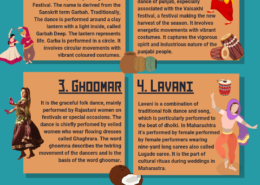Roadmap for Answer Writing To answer the question effectively, it’s important to organize the response by identifying the key themes that unify the folk music and dance forms in India, despite regional variations. Here’s a step-by-step guide to structure the answer: Introduction Start ...
Community participation plays a vital role in folk dance, serving as a foundational element that fosters cultural pride and ensures continuity across generations. Here’s an exploration of how this inclusivity impacts communities: 1. Shared Experience and Collective Identity Cohesion and Bonding: ComRead more
Community participation plays a vital role in folk dance, serving as a foundational element that fosters cultural pride and ensures continuity across generations. Here’s an exploration of how this inclusivity impacts communities:
1. Shared Experience and Collective Identity
- Cohesion and Bonding: Community participation in folk dance promotes a sense of belonging and unity among members. When individuals come together to learn and perform, they build strong social bonds and shared memories, reinforcing collective identity.
- Cultural Representation: As communities engage in folk dances, they actively represent their cultural heritage, showcasing their traditions and values to both themselves and outsiders. This shared ownership of cultural practices enhances a sense of pride.
2. Intergenerational Learning
- Transmission of Traditions: Involvement in folk dance allows older generations to pass down knowledge, techniques, and stories to younger members. This mentorship fosters respect for elders and encourages the younger generation to appreciate and uphold their cultural heritage.
- Adaptation and Evolution: While traditions are preserved, younger participants often bring fresh perspectives and creativity to the dance forms, leading to adaptations that keep the practice relevant. This intergenerational exchange ensures that folk dance evolves while retaining its essence.
3. Cultural Pride and Heritage
- Celebration of Identity: Community participation in folk dance often coincides with local festivals and celebrations, providing opportunities to showcase cultural pride. Performances become a platform for expressing local identity and history, reinforcing community ties.
- Recognition and Visibility: By actively participating in folk dances, communities can gain recognition for their unique cultural contributions, fostering a sense of pride in their heritage. This visibility can lead to greater appreciation from broader audiences.
4. Emotional and Social Well-Being
- Creative Expression: Engaging in folk dance offers a creative outlet for individuals, allowing them to express their emotions and experiences through movement. This expression can enhance mental well-being and provide a sense of fulfillment.
- Social Engagement: Community dance activities create social networks, bringing together diverse groups within a community. This interaction fosters inclusivity and acceptance, promoting harmony among different demographic segments.
5. Preservation of Language and Rituals
- Cultural Practices: Folk dances often incorporate traditional songs and narratives that reflect the community’s history and language. Participation helps preserve these linguistic elements, ensuring that the community’s language and storytelling traditions are not lost.
- Ritual Significance: Many folk dances are tied to local rituals and festivals, linking participants to their cultural roots. This connection reinforces the importance of community rituals and practices in maintaining cultural continuity.
Conclusion
In summary, community participation in folk dance is essential for fostering cultural pride and continuity among generations. By encouraging inclusivity and collaboration, folk dance strengthens social bonds, facilitates the transmission of traditions, and promotes a vibrant cultural identity. This participatory nature not only enriches individual lives but also ensures that the community’s heritage remains dynamic and relevant, creating a living tradition that thrives through collective effort and shared joy.
See less

Model Answer Celebrating Important Life Events Folk music and dances often commemorate significant milestones in life such as births and marriages. For instance, Sohar is a traditional folk music form in Bihar sung to celebrate the birth of a child, while the Baiga Pardhoni dance is performed by theRead more
Model Answer
Many folk music and dance forms are deeply influenced by nature. The Kalbelia dance of Rajasthan mimics the movements of serpents, while the Mayilattam of Kerala and Tamil Nadu features girls dressed as peacocks, celebrating the beauty of nature.
The arrival of different seasons is often celebrated through folk music and dance. For example, Sawnahi in Chhattisgarh is sung during the rainy season, and Faag celebrates the arrival of spring. Similarly, the Rouf dance in Jammu and Kashmir is performed to welcome the spring season.
Many folk traditions are rooted in religious devotion. The Veeranatyam dance of Andhra Pradesh is performed as a tribute to Lord Shiva, while the Chhau dance from Bengal is inspired by epics like the Ramayana and Mahabharata.
Folk music and dance forms also serve as a medium for expressing human emotions. Biraha folk songs from Baghelkhand deal with themes of love, separation, and reunion, while Bara-Masa from the Gangetic plains expresses women’s longing to reunite with their husbands.
Many folk forms convey historical stories or local legends. Dhali, a folk dance from West Bengal, uses swords and shields to narrate heroic tales, while Kachhi Ghodi from Rajasthan celebrates the tales of local bandits.
These common themes demonstrate the interconnectedness of India’s diverse regional cultures, showcasing the unity in diversity that is the hallmark of India’s folk traditions.
See less